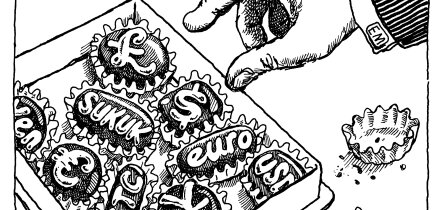For this week's Learning Curve in PDF format, click here.
Last week's Learning Curve introduced the gamma model as a replacement to the base correlation approach. This model can be implemented using standard methods, provides a new way of risk managing credit correlation and gives its own interpretation of events of May 2005.
Parameter History--The Auto Crisis May 2005
The gamma model is driven by two parameters called gamma and phi. In base correlation terms, phi controls the average level of the base correlation curve and increasing phi shifts the curve up in parallel. Gamma controls the slope of the base correlation curve and increasing gamma flattens the curve. Low gamma gives a steep curve and also corresponds to low credit spread volatility and a high degree of lumpiness (large jumps which are infrequent).
We can calculate the historical gamma and phi parameters from old market data. The following graphs show the term structure of both parameters for the on-the-run CDX basket from April 1, 2005 to Jan. 9, 2007.
One striking feature is the behaviour of the parameters during the auto crisis of May 2005. The five-year gamma level was trading quite high at around 80% and crashed down to 10%. This caused equity spreads to widen and mezzanine spreads to tighten, corresponding to a steepening of the base correlation curve. The phi (correlation) levels did not change particularly during this period, though they became more volatile later.
Some investors had on the so-called positive carry trade, which sold equity protection and bought mezzanine protection. This trade was about flat in credit spread risk and long correlation. Unknown at the time, this was also a long gamma position. As gamma crashed, so the position lost money.
More recently, phi has been stable but gamma has been increasing to relatively high levels for all maturities. This corresponds to a flattening of the base correlation curve and an increase in mezzanine spreads relative to equity and senior tranches, which some have called the reverse correlation crisis of November 2006.
In terms of the Gamma model, these two events can be described as respectively a gamma crash and a gamma rally.
New Techniques For Risk Management
Under the Gamma model, there are two sorts of risk-- credit spread risk and correlation skew risk. The model shows individual spread risk for each name in the basket, as it is a bottom-up model which describes each name's behaviour. It also gives risk to the gamma and phi parameters.
Typically, gamma risk is negative for equity and senior tranches, and positive for mezzanine tranches (for bought protection positions). Phi risk, like base correlation risk, is negative for junior tranches and positive for mezzanine and senior tranches. The table shows risk for a USD10 million bought-protection position in each tranche, for a 1% increase in either gamma or phi. (Five-year CDX 125 S7 as at 9-Jan-2007.)
This provides a new way of managing risk on CDO portfolios. Gamma and phi risk can be added up over all tranches in a portfolio, even including bespoke tranches, bespoke baskets and exotic products (see below). The total gamma and phi risks can then be monitored and managed by trading in liquid tranches to achieve the desired exposure.
This is an improvement on base correlation risk management which is essentially inventory-based, and finds it difficult to net risk across either the capital structure or bespoke baskets/products.
Practical evidence of using gamma-phi risk management on Nomura's books since August 2006 confirms that it is an efficient and workable real-world technique, which is significantly less problematic than base correlation.
It is easy to be right with hindsight, but having access to the Gamma model's risk management in May 2005 might have been helpful to market participants who were unwittingly running big gamma and phi positions.
Exotic Baskets And Portfolio Products
The Gamma model will price bespoke baskets, given suitable levels of gamma and phi for that basket. Whilst they can never be known with absolute certainty, they can be reasonably estimated by reference to the liquid CDO market. Not only can CDX and iTraxx investment-grade tranches be seen, but also the high-yield CDX HY basket is visible. Gamma and phi levels can be calibrated to all these baskets.
Higher-yielding baskets tend to have higher gamma levels than IG baskets. A simple scheme to discover bespoke gamma and phi levels is linear interpolation against basket index spread between the liquid investment-grade and HY (high-yield) baskets. That is
The estimate is not certain, but it provides a starting point for traders' judgement. Risk managers can also understand the assumptions being made and estimate the margin for error in terms of gamma and phi.
More exotic products, such as CDO-squareds, long/short CDOs, and potentially CDO options, can also be priced under the model. By conditioning on the global factor, the product can be priced using the conditional independence of the names. This is described below in more detail in the CDO case. This approach to exotic products will automatically include correlation skew in the pricing, in a dynamic arbitrage-free way. This compares with the base correlation approach which is problematic for exotic products, because it is not clear which correlation to use.
The model can also be extended to address other credit management concerns such as gap risk on constant proportion portfolio insurance or leveraged trades, and counterparty risk.
Implementation
The model can be implemented in a similar way to a standard implementation of the Gaussian copula by conditioning on the global factor. The Gamma model, in essence, is
where *g is the global gamma process and each *i is an idiosyncratic gamma process. Let us write F(x; *) for the distribution function of the gamma distribution with parameter *, and qi(t) for the survival probability of entity i to time t. Conditional on the value of the global factor being y, the conditional survival probability of entity i is
The entities are now conditionally independent, so these conditional probabilities can be used in approximations such as a normal-approximation to the basket loss or the bucket algorithm of Hull and White to calculate the conditional expectation of the trade's payoff given the global factor.
This conditional expectation can then be integrated against the possible values of y, which is governed by the gamma distribution F(x; **t). This can be done using simple methods, such as Simpson integration, or more sophisticated quadrature techniques.
The gamma distribution is already well approximated. See, for example, Numerical Recipes (Press et al 1988). The inverse distribution can be calculated with interval bisection and/or Newton-Raphson. Run-time performance for the Gaussian copula and the Gamma model should be broadly similar, and gamma is actually simpler than base correlation as the parameters do not vary with tranche attachment point.
Conclusion
The gamma model moves away from the disadvantages of the base correlation approach. It is a no-arbitrage model which fits the market reasonably well. It has two intuitive parameters--correlation phi, and lumpiness/volatility gamma--which give a useful interpretation of recent market movements including the auto crisis of May 2005. The two parameters also enable a new and practical way of managing risk, based on gamma and phi.
Importantly, the new model can be used for a variety of other products, such as bespoke baskets, CDO squareds, and even more exotic products. This is possible because the model drives the evolution of credit in a skew-consistent way, so that it automatically includes correlation skew in the pricing. The model is also straightforward to implement.
This week's learning curve was written by Martin Baxter, quantitative analyst at Nomurain London.





